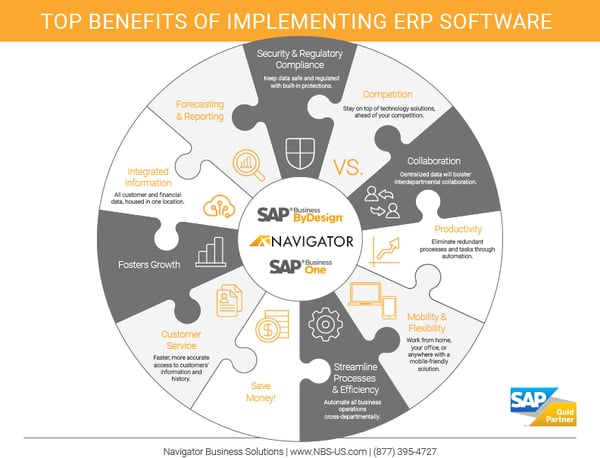
Why Now is the Time to Upgrade Your ERP System
If it isn’t broken, don’t fix it.
While that may be wise advice for most areas of your business, it can lead you astray and serve as a convenient rationalization when it comes to technology upgrades. For while your aging accounting and enterprise resource planning software might not technically be broken, it likely is broken from a functionality perspective. The functions you needed seven years ago might still work, but new requirements and innovation that have emerged recently are absent or lacking. And this puts your business at a competitive disadvantage
Nobody likes upgrading their ERP software. Rolling out ERP software upgrades historically has been a painful, expensive process that upends how employees work and business processes function. Upgrades are painful and best avoided whenever possible—like switching doctors.

Recent technology advances such as cloud computing, smartphones, artificial intelligence and widespread ecommerce make an ERP upgrade necessary, however. And the good news: While still involved, ERP upgrades have gotten a lot easier and less expensive with the rise of cloud computing.
Here’s why you should stop avoiding a systems upgrade and start evaluating new ERP solutions today.
- Better Security
Data security has become a huge issue both for consumers and regulators. Directives such as the European Union’s General Data Protection Regulation and California’s Consumer Privacy Act of 2018 put a high price on failure to properly secure company data.
Old and on-premise ERP systems are a ticking time bomb from a security perspective. That’s because the older a system gets, the more likely workarounds have been developed for compromising the system. With on-premise solutions, there also is the challenge of keeping up with security patches and system upgrades that keep a system current.
The latest generation of ERP systems does not suffer from these challenges, however, because they live in the cloud. Businesses that use modern ERP solutions have security handled by the vendor, as well as ongoing technology upgrades to keep systems technologically up to date at all times.
- Ecommerce Compatibility
Online sales is a misnomer; almost everything is sold online now, with offline sales volume diminishing further each year. What once was just one of many sales channels has now become THE sales channel for most businesses.
Fully taking part in today’s ecommerce marketplace requires real-time connectivity to both online storefronts and B2B or B2C marketplaces such as Amazon and others. Even businesses that don’t directly sell online need systems that connect to other businesses for supply chain reasons.
This connectivity was optional with the previous generation of ERP solutions, and it often required challenging integrations. Today all major ERP solutions lean heavily on connectivity, however, and facilitate it by living in the cloud.
Even if your existing system is ecommerce enabled, it doesn’t work anywhere as well as the current generation of ERP solutions. This alone is reason enough to upgrade your ERP solution.
- Anywhere Access
Mobile computing is about much more than just telecommuting workers and Millennials that work exclusively from their phones. The widespread adoption of smartphone-based computing is enabling faster field service, more complete data for sales reps, added precision on the shop floor and real-time data entry, among other benefits. Mobile computing is changing business all over the place.
The problem is that older ERP solutions are not mobile-native applications in most cases. They might provide clunky online access, but they were built for a time when the digital world came primarily through office laptops.
Modern ERP solutions have mobility and anywhere access as foundational functionality. Businesses can get by without anywhere access to their data for a bit longer, but the window is closing fast. That means any business that doesn’t have its business systems in the cloud should be moving in that direction now.
- Automated Real-Time Data
Technology has increased the pace of business exponentially. Business models must be changing all the time, and firms are making constant adjustments now as a matter of course. Financial and operational data can’t wait for the next report, it needs to be accessible in real-time—and automatically acted upon in many cases.
Does your current ERP system give you real-time data and a complete picture of your business as it exists today? If the answer is no, some of your competitors are ahead of you and probably acting on changing conditions first.
Much of the real-time business adjustment going on right now is not immediately obvious, but soon it will be; real-time business adjustment is fast becoming table stakes. So make sure your ERP system keeps you in the game.
- Better Inventory Control
Walmart revolutionized retail with its just-in-time supply chain in the 1990s. But now almost every business operates from these lean principles, with reduced inventory and precise supply chain management. The next step: inventory tracked and precisely managed with internet-connected devices.
While inventory control has been a central component of ERP systems for decades, the emergence of internet-of-things is a recent evolution. Older ERP systems don’t natively support IoT devices, and this holds back businesses from adopting the next generation of inventory control systems.
Businesses should be preparing for IoT devices now, before IoT becomes a standard feature of inventory control in the near future when 5G cellular technology fully enables it. Now is the time to get ready for the next generation of inventory control—and this next generation requires cloud-based ERP.
So while upgrading your existing ERP system might sound unappealing, you shouldn’t put it off. Your business might be running fine today, but the clock is ticking.